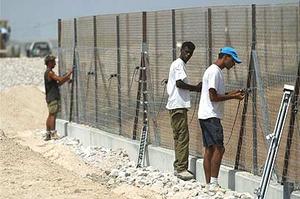Perimeter protectionSmart fence distinguishes real from imagined threats
A new sensor system can tell between someone simply leaning against a fence and a ne’er-do-well sneaking around; the device, developed by researchers at the University of Southern California, contains signal processing based on the way the brain works

Smart fence being installed on the Egypt-Israeli border // Source: ynetnews.com
New small, low-powered devices modeled after the human brain can help make security smarter by being able to distinguish between a person sneaking around and trees simply rustling in the wind.
Video cameras can only go so far, especially in monitoring every inch of an expansive perimeter, such as an airport. Yet smart surveillance can be critical, as demonstrated by the suicide bombing in Moscow’s Domodedovo Airport on 24 January that killed 35 people. One problem is that video analysis can create false positives when there is significant background movement due to weather. Sight lines can be obscured by trees, structures, and vine-covered fences.
To get around those issues, researchers at the University of Southern California have developed smart devices that contain signal processing based on the way the brain works.
Each one has seismic sensors programmed to recognize types of movements, including footsteps. The devices can be placed in the ground or attached to a fence, sending an alert wirelessly to a command center under certain conditions, such as an attempt to climb the fence.
“We’ve been commissioned by the TSA and the Navy to develop these technologies for areas where a camera can’t be installed,” said Alireza Dibazar, a research professor at University of Southern California’s Biomedical Engineering Department who is leading the project. “We are trying to make it like how a human brain functions and performs.”
Other scientists are developing an optical vibration-based system, but Dibazar said he thinks it would require more power to operate. The USC devices are battery-powered and only go into full-power mode when they detect unauthorized movement.
Once, when the USC team was working on their devices inside an airport office, a stranger walked across the runway and knocked on their door.
“We all freaked out,” Dibazar said. The man turned out to be having a medical emergency, but if he had wanted to do something destructive it would have been too late, Dibazar said.
Discovery News reports that USC has tested “Smart Fence” devices at high schools and several small airports around Los Angeles, and did a successful large-scale demonstration at the Northwest Florida Beaches International Airport near Panama City, Florida. The team has since been contacted by other airports interested in installing the sensors. Now the researchers are looking for a company that can commercialize the technology.
According to Robert Josefek, an adjunct professor at the Naval Postgraduate School’s Center for Homeland Defense and Security, the devices’ ability to identify potentially threatening sounds and vibrations is important for securing international borders, airports and critical infrastructure facilities.
“Using various technologies — video, above-ground motion sensing, acoustic and vibration recognition systems in combination — and matching the technology to the environment makes for a sensible, multi-layered approach to border security,” he writes in a forthcoming article for Homeland Security Journal that describes the devices.
The devices are constantly on alert. When the researchers were testing the sensors at one coastal location, they received an alert about human footsteps in the middle of the night, Dibazar said. “It was people going out there from 1 to 2 a.m. for fishing.”
